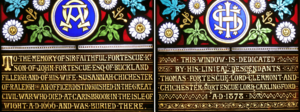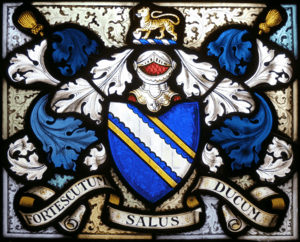Faithful Fortescue facts for kids

Sir Faithful Fortescue (born 1585, died 1666) was an important figure from Dromiskin in County Louth, Ireland. He served as the Governor of Carrickfergus, a key English stronghold in Ulster. During the English Civil War, he was a commander for the Cavaliers, who supported King Charles I.
Contents
Who Was Sir Faithful Fortescue?
His Family and Early Life
Faithful Fortescue was born in 1585. He was the third son of John Fortescue from Buckland Filleigh in Devon, England. His mother was Susannah Chichester. Her brother, Sir Arthur Chichester, would become very important in Faithful's life.
Faithful was named after his uncle, also called Sir Faithful Fortescue. The Fortescue family was well-known, with a long history in England. They were related to Sir John Fortescue, a famous judge from the 1400s.
Moving to Ireland
In 1598, when Faithful was young, his uncle Sir Arthur Chichester went to Ireland to lead a group of soldiers. Faithful went with him. He later wrote that his uncle helped him get his start and make his fortune in Ireland.
In 1604, Sir Arthur Chichester became the Lord Deputy of Ireland, which was like being the King's main representative. During this time, many English and Scottish people moved to Ireland in a process called the Plantation of Ulster. Faithful Fortescue gained land and important jobs in northern Ireland.
Constable of Carrickfergus Castle
In 1606, Faithful was made the Constable of Carrickfergus Castle for life. This was a very important job because Carrickfergus Castle was a major fort in northern Ireland. He also received a large area of land in County Antrim, which he named the "manor of Fortescue."
A Career in Politics
Faithful Fortescue also became a Member of Parliament in Ireland. He represented different areas like Charlemont, Dungannon, and County Armagh in the Irish Parliament.
In 1624, he was given command of a company of soldiers. These soldiers were meant to serve in the Netherlands, but Faithful was allowed to join a regiment going to Ireland instead.
Challenges with Lord Wentworth
Later, in 1633, Lord Wentworth became the Lord Deputy of Ireland. He asked Fortescue to raise a group of horse soldiers (cavalry). This led to many disagreements between Fortescue and Wentworth. Wentworth dismissed some of Fortescue's new soldiers and caused problems with payments. Eventually, Wentworth removed Fortescue from his command.
The Irish Rebellion and Civil War
The Irish Rebellion of 1641
In 1641, a big rebellion broke out in Ulster, Ireland. Many towns were taken by rebels, and Drogheda was threatened. Faithful Fortescue was the Governor of Drogheda at this time. However, he didn't have enough soldiers to defend the town. He decided to leave his post and go to England to get help.
His eldest son, Chichester Fortescue, stayed behind with his company of soldiers and sadly died during the siege of Drogheda. His second son, John Fortescue, was also killed by the rebels.
Fighting in the English Civil War
In 1642, Fortescue was chosen to lead a group of horse soldiers to help stop the Irish rebellion. He also raised a company of foot soldiers. However, these soldiers were instead sent to fight in the English Civil War in England.
Fortescue's troop was placed under the command of Robert Devereux, 3rd Earl of Essex, who fought for the Parliament. But before the battle of Edgehill, Fortescue, who was a major, secretly agreed to switch sides. During the battle, he and his troop rode over to join the King's army. Some of his soldiers were accidentally hurt by the King's cavalry because they were still wearing the Parliament's orange colors.
After the battle, Fortescue was given command of a royal infantry regiment. He served with the King's army for the rest of the war.
Later Life and Legacy
Continued Royalist Service
In 1647, Fortescue joined the Marquis of Ormonde in his campaign in Ireland. After the royal army retreated, Fortescue went to the Isle of Man and then to Wales. He was arrested and imprisoned by the Parliament.
He later managed to join King Charles II in Scotland in 1651 and fought in the battle of Worcester.
Return to England
After the King's side lost, Fortescue went to Europe and stayed there until King Charles II was restored to the throne in 1660. He was given back his job as Constable of Carrickfergus Castle, which he later passed on to his oldest surviving son, Sir Thomas Fortescue. He also became a "Gentleman of the Privy Chamber," which meant he worked closely with the King.
Death and Memorials
In 1665, to avoid the Great Plague of London, Fortescue moved to the Isle of Wight. He died there in May 1666, at over 80 years old, and was buried at Carisbrooke Church.
Later, his family honored him with memorials:
- A brass tablet was placed in St Mary's Church, Carisbrooke, Isle of Wight, by his descendant Lord Clermont in 1866.
- In 1878, Lord Clermont and his brother Lord Carlingford put up a stained glass window in Buckland Filleigh Church in Devon, where Faithful was born.
Family and Descendants
Sir Faithful Fortescue was married twice.
- His first wife was Anne Moore, who passed away in 1634. They had 16 children together, including ten sons and six daughters.
- Chichester Fortescue (died 1641) was his eldest son. He became a lawyer and also served as a Member of Parliament. He died during the Siege of Drogheda, where his father had been governor.
- John Fortescue (died 1642) was his second son. He was killed by rebels in Ireland.
- Sir Thomas Fortescue (around 1620–1710) was his third son and the oldest to survive. He also fought for the King and inherited his father's estates. He is the ancestor of Lord Clermont and Lord Carlingford.
- His second wife was Eleanor Whitechurch, whom he married by 1637. They did not have any children.
Where He Lived
Sir Faithful Fortescue had two main homes:
- Dromiskin in County Louth, Ireland. This was a pleasant and healthy place, which he held by a long lease. He later bought more land around it.
- Galgorm Castle, near Ballymena, County Antrim. Fortescue built this castle in 1618. It is still standing today and is considered a beautiful example of early Jacobean architecture in Ireland.
His Writings
Sir Faithful Fortescue wrote a short biography about his uncle, Sir Arthur Chichester, 1st Baron Chichester of Belfast. It was called An Account of the Rt. Honourable Arthur, first Lord Chichester, Lord Deputy of Ireland, by his Nephew, Sir Faithful Fortescue, Knight. He said that "no man knew his composition and disposition better than myself," meaning he knew his uncle very well. This book was published in 1869 by his descendant, Thomas Fortescue, 1st Baron Clermont.
|




